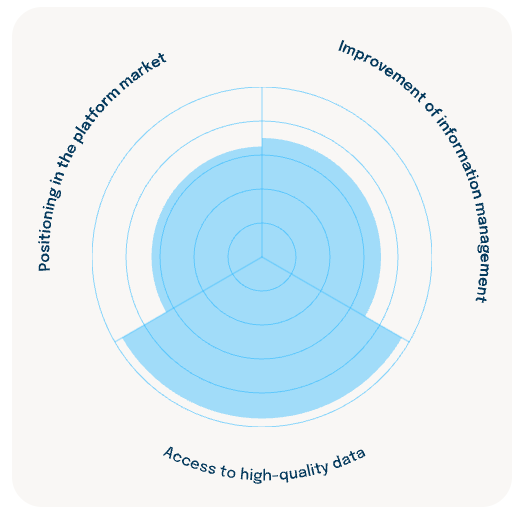Concept
This section presents the various considerations, plans and contextual issues that have informed our vision of a national health platform. This is where questions such as what content should be provided and how its quality can be ensured are explored. Other questions include how to cultivate a digital ecosystem that benefits everyone involved, what kind of organization might serve as the platform operator, and how to finance the platform.
Having collected and compiled the answers to these and many other questions in a rapidly shifting context, we’ve decided to publish our findings now and adapt our concept as things evolve.
Overview
Together with the Fraunhofer Institute (IESE) and several other experts, we have created a blueprint for a digital ecosystem that is informed by our conceptual considerations. Illustrating specific concepts and ideas, this blueprint is intended to serve as a source of inspiration and ideas for those aiming to build a national health platform. The contributions in this section provide an overview of our approach.
Conceptual considerations: an overview
Benefit Model
A digital ecosystem’s success is determined primarily by the benefits it generates for its participants. Its capacity to balance the interests of various actors is crucial to ensuring genuine benefits for everyone involved. This is the key to fostering network effects that drive rapid growth. For our vision of a national health platform, we’ve drafted an initial benefit model that prioritizes patients without losing sight of the needs of traditional actors in the healthcare and health-tech sectors.
Benefit model for a national health platform
Ecosystem design: Benefits for all
Engagement
User engagement is essential when designing a national health platform. By systematically capturing the needs, abilities, and desires of various target groups, valuable insights can be gained. Additionally, potential users should actively participate in the development process and provide important input for the design. The younger generation, in particular, should be included in the development process, as they are the future users of a digital healthcare system.
Shaping the future of digital healthcare
Ownership Model
Efforts to implement a national health platform must be anchored within a sustainable institutional framework that has the authority to manage its operation. This raises the question as to which administrative institution is most appropriate for such a platform. Can an existing organization assume the role of platform operator, or is an entirely new structure needed for this purpose? In collaboration with the Bielefeld-based law firm Brandi Rechtsanwälte, we’ve explored various options, including the potential role of state actors, and present our findings here. Additional contributions addressing the issue of ownership models and governance will follow.
The state as a provider of information: What is the government allowed to do?
Ownership: Public or private?
Operating Model
Breathing life into a digital ecosystem requires meticulous forethought in considering and planning the interplay of people, processes and technologies. This includes accounting for structural and operational considerations as well as financial aspects. In this section, we've compiled all contributions relating to the operational framework of the proposed national health platform. This encompasses discussions on funding strategies, production processes and collaborative partnerships. As the project advances, we will continue to supplement the content in this section with new contributions.
Invest in benefits: Financing models for health ecosystems
Successfully establishing health ecosystems – models from abroad
Creating vs. brokering editorial content: Where does the content come from?
Quality Model
A cornerstone of our product vision for a national health platform rests on the quality-driven selection of trustworthy health information. Users must have confidence in the accuracy, timeliness and unbiased nature of the information they encounter. This is essential to cultivating trust. Working together with international partner organizations, we have launched an initiative to spotlight trusted health information providers to be featured on platforms. Our vision includes the creation of a digital “InfoCure” certificate which could potentially change the information landscape.
InfoCure: Making quality visible
Software Architecture
Software architecture serves as the backbone of a digital ecosystem, wielding significant influece over its performance, security and usability. A well-designed software architecture facilitates rapid scalability, ensures the smooth and seamless exchange of data, and establishes the groundwork for user-friendly, responsive and coherent user interfaces. When it comes to realizing a national health platform, technical planning helps prepare for the costs involved and feasibility issues. As the project progresses, we will update this section with topical contributions.
Initial thoughts on the technical structure of the national health platform
Your feedback is important to us
To contact our project team, please use our form. We look forward to your message and will get back to you as soon as possible.












